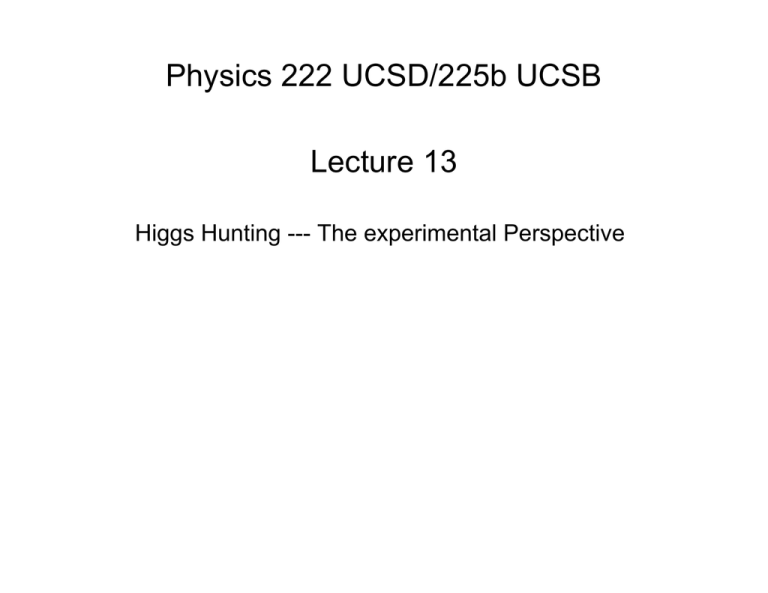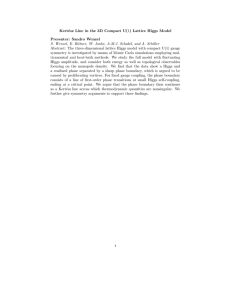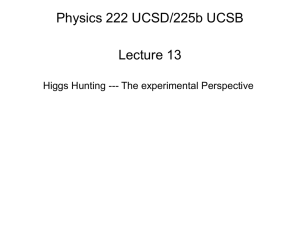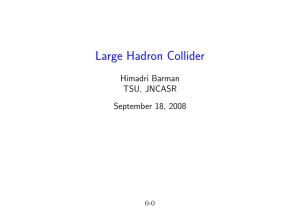Physics 222 UCSD/225b UCSB Lecture 13 Higgs Hunting --- The experimental Perspective
advertisement

Physics 222 UCSD/225b UCSB Lecture 13 Higgs Hunting --- The experimental Perspective The higgs vertices • • • • • hWW ∝ mW2 /v hZZ ∝ mZ2 /v hff ∝ mf /v hhWW ∝ mW2 /v2 hhZZ ∝ mZ2 /v2 v = vev of higgs ~ 246GeV All of these vertex factors can in principle be probed experimentally. In practice, higgs physics is difficult because e,u,d have small mass, and thus couple weakly to higgs. Particles we can easily build colliders with couple very weakly to higgs !!! Depend on “higgsstrahlung” off W,Z and loops for higgs production !!! Production Mechanisms (e+e-) • Associative production with Z. – Depends on ZZh coupling: Production Mechanisms (p+p-) Production at Tevatron E.g.: For h160 we expect ~430 higgs to be produced in 1fb-1. Production at LHC E.g.: For h160 we expect ~26,000 higgs to be produced in 1fb-1. Noteworthy Details • gg production of higgs dominates. – And scales by factor ~60 from Tevatron to LHC. • Subdominant processes differ between Tevatron and LHC. – Associative production does not scale up as much as gg because it requires q qbar in the initial state. • Our understanding of PDF from last quarter applies here !!! – tth is close to competitive to Zh and Wh at LHC. • More on this later. Aside on weak boson fusion • Interesting signature: This process may play a role at the LHC if the rapidity gap signature can be made to work well. WBF ATLAS study. Both distributions normalized to unity. Solid = parton level. Data = after reconstruction. The higgs self coupling vertices • hhh ∝ mh2 /v • hhhh ∝ mh2 /v2 100fb 10fb 1fb While these vertices are very interesting theoretically, as they define the higgs potential, they are even more difficult experimentally. In Standard Model these 2 diagrams interfere destructively, making the rate for hh production at LHC O(10-100)fb. hh production x10-4 smaller than h production at LHC !!! Higgs Decay b dominates Linear growth with mh Above threshold for VV production: WW and ZZ are 2:1 W,Z dominate over fermions above threshold. Higgs Decays via Loops h -> γγ h -> Zγ h -> gg Γ ∝ mh3 x F((mf/mh)2) Here f=fermion in the loop. For photon and Z, there can also be a W in the loop. F modifies the dependence on higgs mass significantly, and differently for each case. mh3 Threshold from VV* to VV 2(MZ-MW) mh 136GeV Aside on Branching Ratio • BRi = Γi / Γtotal • If Γi varies little near threshold of WW but ΓWW increases dramatically, then Bri for all final states except WW will decrease dramatically. • This significally changes the higgs phenomenology near WW threshold. Detection Issues • Triggering – For the purpose of higgs physics, ATLAS and CMS trigger only on leptons and photons. => Need a leptonic W or Z decay for all higgs decays except for two-photons !!! • W -> (e || mu) nu ~23% • Z -> (ee || mumu) ~7% • top -> Wb -> (e || mu) nu ~23% Signal vs Background @ LHC σ(bb) / σ(h120) ~105 ⇒ hopeless σ(tt) / σ(tth120) ~104 ⇒ very difficult but at least there are clear signatures: ll & MET & bbbb l & MET & bbbb σ(WW) / σ(h160) ~5 pb Low Mass Higgs @ LHC • Example: 115GeV • h -> γγ has a BR penalty of ~ 10-3 • tth -> l & MET & bbbb has a Xsect x BR penalty of ~3x10-3 • h -> WW -> ll & MET has a BR penalty of ~ 6x10-3 • h -> ZZ -> 4l has a BR penalty of ~ 5x10-5 Comparing the penalty gives you an idea of the signal yield. Estimating the bkg is harder. Low Mass Higgs @ LHC • Example: 136GeV • h -> γγ has a BR penalty of ~ 2x10-3 • tth -> l & MET & bbbb has a Xsect x BR penalty of ~3x10-3 • h -> WW -> ll & MET has a BR penalty of ~ 3% • h -> ZZ -> 4l has a BR penalty of ~ 5x10-4 Comparing the penalty gives you an idea of the signal yield. Estimating the bkg is harder. Low Mass Higgs • Example: 160GeV • h -> WW -> ll & MET has a BR penalty of ~ 6% – At Tevatron we expect 430 higgs / fb-1. • 26 after BR penalty • 4 after complete CDF analysis • With a bkg of 130 events from WW. – At LHC we expected 26,000 higgs / fb-1 • 1600 after BR penalty • ?? After complete CMS analysis. Ratio of h160/WW changes from 1/30 to 1/5 when going from Tevatron to LHC !!! Let’s take a closer look at Tevatron • Tevatron searches divide up in two types: – mh < ~140GeV they use h -> bb with associate production of W or Z. • Leptonic decay of W or Z provides the necessary trigger. – Wh -> l & MET & bb – Zh -> ll & bb and MET & bb – mh > ~130GeV they use h -> WW -> ll & MET – Small overlap region where both sets of analyses have some sensitivity. • They plot two sets of curves: – Expected sensitivity, i.e. 95% CL limit for higgs Xsect. – Actual 95% CL limit. • Both sets of curves are expressed as ratios to the Standard Model Xsect at NNLO. A note of caution • Before we look at the expected sensitivity for the LHC experiments, let’s look at what the Tevatron experiments expected their senstivity to be before they started data taking. Higgs Sensitivity at the Tevatron Reality after Data taking Fantasy before Data taking Sensitivity at ~110GeV is about x8 worse than expected. Sensitivity at ~160GeV is about x1.4 worse than expected. This is for 14TeV




